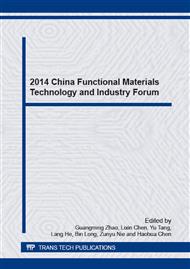[1]
A. M. Algra, P. M. Rothwell: Effects of regular aspirin on long-term cancer incidence and metastasis: a systematic comparison of evidence from observational studies versus randomised trials. The lancet oncology Vol. 13 (2012) No. 5, p.518.
DOI: 10.1016/s1470-2045(12)70112-2
Google Scholar
[2]
M. S. Refat, T. Sharshar, K. M. Elsabawy and Z. K. Heiba: Physicochemical impact studies of gamma rays on aspirin, analgesics drug and its metal complexes in solid form: Synthesis, spectroscopic and biological assessment of Ca (II), Mg (II), Sr (II) and Ba (II) aspirinate complexes. Journal of Molecular Structure Vol. 1047 (2013).
DOI: 10.1016/j.molstruc.2013.04.031
Google Scholar
[3]
J. S. Čech, J. Chudoba, and P. Grau: Determination of kinetic constants of activated sludge microorganisms. Water Science & Technology Vol. 17 (1985), p.259.
DOI: 10.2166/wst.1985.0135
Google Scholar
[4]
F. F. Bamoharram, M. M. Heravi and M. Roshani, et al.: Catalytic method for synthesis of aspirin by a green, efficient and recyclable solid acid catalyst (Preyssler's anion) at room temperature. Journal of the Chinese Chemical Society Vol. 54 (2007).
DOI: 10.1002/jccs.200700146
Google Scholar
[5]
Y. q. Peng, and G. h. Song. Heteropolyacid-Catalyzed Synthesis of Aspirin. The Chemical Educator Vol. 5 (2000), p.144.
DOI: 10.1007/s00897000384a
Google Scholar
[6]
M. Heravi, Majid , F.K. Behbahani, and F. F. Bamoharram: Acetylation of alcohols, phenols and salicylic acid by heteropoly acids in acetic anhydride: a green and eco-friendly protocol for synthesis of acetyl salicylic acid (Aspirin). Arkivoc Vol. 16 (2007).
DOI: 10.3998/ark.5550190.0008.g13
Google Scholar
[7]
T. Beena, M. K. Mishra, and R. V. Jasra: Solvent free synthesis of acetyl salicylic acid over nano-crystalline sulfated zirconia solid acid catalyst. Journal of Molecular Catalysis A: Chemical Vol. 317 (2010), p.41.
DOI: 10.1016/j.molcata.2009.10.019
Google Scholar
[8]
H.V. Erlinda, A.P.D. Loupy, and J.M. Collazo Garcia: Synthetic procedure for the manufacture of aspirin. U.S. Patent No. 6, 278, 014. (2001).
Google Scholar
[9]
J.R. Vir, B. Tyagi, and M.K. Mishra: Green catalytic process for the synthesis of acetyl salicylic acid. U.S. Patent No. 7, 544, 831. (2009).
Google Scholar
[10]
G. Peng, et al. : Quasi-solid state synthesis of EU-1 zeolite and its catalytic properties for the isomerization of C8 aromatics. Petroleum Science Vol. 9 (2012), p.544.
DOI: 10.1007/s12182-012-0241-6
Google Scholar
[11]
M.M.J. Treacy, and J. M. Newsam: Two new three-dimensional twelve-ring zeolite frameworks of which zeolite beta is a disordered intergrowth. Nature Vol. 332 (1988) No. 6161, p.249.
DOI: 10.1038/332249a0
Google Scholar
[12]
X. Jie, et al. : Synthesis and properties of zeolite/hydrated iron oxide composite from coal fly ash as efficient adsorbent to simultaneously retain cationic and anionic pollutants from water. Fuel Vol. 116 (2014), p.71.
DOI: 10.1016/j.fuel.2013.07.126
Google Scholar
[13]
W.L. Yan, and R.M. ZHOU: Experiment Study on Denitrification and Dephosphorization by Combination Process of MAP and Zeolite Desorption. China Environmental Protection Industry Vol. 2 (2010), p.18.
Google Scholar
[14]
C. D. Chang and A.J. Silvestri: The conversion of methanol and other O-compounds to hydrocarbons over zeolite catalysts. Journal of catalysis Vol. 47 (1977) No. 2, p.249.
DOI: 10.1016/0021-9517(77)90172-5
Google Scholar
[15]
G. Peng, L. X. Feng and Z. Sahng et al. : Quasi-solid state synthesis of EU-1 zeolite and its catalytic properties for the isomerization of C8 aromatics. Petroleum Science Vol. 9. 4 (2012), p.544.
DOI: 10.1007/s12182-012-0241-6
Google Scholar
[16]
G. D. Yadav and Akhilesh R. Yadav: Insight into esterification of eugenol to eugenol benzoate using a solid super acidic modified zirconia catalyst UDCaT-5. Chemical Engineering Journal Vol. 192 (2012), p.146.
DOI: 10.1016/j.cej.2012.03.064
Google Scholar
[17]
X. N. Wang Z. Zhao and C. M. Xu, et al. : Effects of light rare earth on acidity and catalytic performance of HZSM-5 zeolite for catalytic cracking of butane to light olefins. Journal of rare earths Vol. 25 (2007) No . 3, p.321.
DOI: 10.1016/s1002-0721(07)60430-x
Google Scholar
[18]
R. Birjega, O. D. Pavel and G. Costentin, et al. : Rare-earth elements modified hydrotalcites and corresponding mesoporous mixed oxides as basic solid catalysts. Applied Catalysis A: General Vol. 288 (2005) No. 1, p.185.
DOI: 10.1016/j.apcata.2005.04.030
Google Scholar
[19]
C. M. L. Wu, D. Q. Yu and C. M. T, et al. : Properties of lead-free solder alloys with rare earth element additions. Materials Science and Engineering: R: Reports Vol. 44 (2004) No. 1, pp.1-44.
DOI: 10.1016/j.mser.2004.01.001
Google Scholar
[20]
O. Masakuni, and M. Kimura. Preparation and characterization of zirconium dioxide catalyst supports modified with rare earth elements. Journal of the Less Common Metals Vol. 171 (1991), p.195.
DOI: 10.1016/0022-5088(91)90143-r
Google Scholar
[21]
L. Ma, D.S. Wang and J.H. Li, et al. : Ag/CeO2 nanospheres: Efficient catalysts for formaldehyde oxidation. Applied Catalysis B: Environmental Vol. 148-149 (2014), pp.36-43.
DOI: 10.1016/j.apcatb.2013.10.039
Google Scholar
[22]
G. Peng, X.F. Li and S. Zhang, et al. : Quasi-solid state synthesis of EU-1 zeolite and its catalytic properties for the isomerization of C8 aromatics. Petroleum Science Vol. 9 (2012) No . 4, p.544.
DOI: 10.1007/s12182-012-0241-6
Google Scholar
[23]
C. J.V. Oers. K.G. Marek and K. Sadowska, et al. : In-situ IR spectroscopic study to reveal the impact of the synthesis conditions of zeolite β nanoparticles on the acidic properties of the resulting zeolite. Chemical Engineering Journal Vol. 237 (2013).
DOI: 10.1016/j.cej.2013.10.041
Google Scholar


